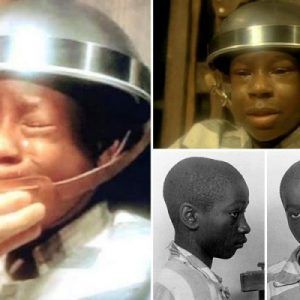This is the true story of George Stinney Jr., as retold by Lesalon Kasaine
***
A young black boy is escorted by the police towards the execution chamber at South Carolina State Penitentiary. He is frail, tired, and teary. The ill-fitting prisoner jumpsuit falls on his tiny body like an oversized coat hanging on a scarecrow. Under his arm, the boy clutches a Bible, because after everything has played out the way it has, the only hope standing between him and death is God.
In the next few minutes, he will breathe his last, in a brutal way. Jolts of electricity will fry his brains and kill him, with a couple of people watching. These people are witnesses who have come to witness his death after the court found him guilty of child murder, within 83 days, and sentenced him to death by electrocution. It’s June 16th, 1944.
A few hours ago while in his cell, watching the long hand of the clock inch closer to his execution time, the young black boy cried out to his cellmate Wilfred “Johhny” Hunter, “I didn’t do it. Why would they kill me for something I didn’t do?”
Wilfred “Johhny” Hunter would later tell the world what the boy said to him. Only that it would be too late to undo the high-power volts of electricity that fried his brain while tied to an electric chair, with state officers and some members of the public watching on.
***
Getting him to fit in the electric chair is an arduous task. To fit properly in the chair, the boy has to sit on his Bible. He is tiny and young. The type of criminals that designers of electric chairs had in mind are older, mature people. The electrodes are too big for his legs, and even the straps can't hold the boy to the chair. That’s not all. The mask is also too big, they have to improvise and just put it over his face, unfastened.
Their improvisation works.
“Do you have any last words?” The state electrician asks the boy.
In tears and fear and hopelessness, the boy answers, “No, Sir.”
The state electrician flips a switch. 2400 volts electrocute the boy. The jolts are too strong, his mask falls off. Witnesses are met with the boy’s horrified face; mouth open in a wordless scream, eyes wide and teary. Saliva is drooling from the corners of his mouth. The electrician electrocutes the young boy again to finish the job. Two more jolts and death loosens his soul. The end of his life, but for us, the beginning of his background story.
The name of the boy is George Stinney Jr., and he goes down in history as the youngest ever to be executed in the U.S. He was only fourteen. This is his story, with details of events that unfurled and brought him from being a happy boy looking after their family cow in Alcolu to the boy in the electric chair.
***
Alcolu, South Carolina
March 23rd, 1944
Segregation of the blacks from the whites is rife. The idea is to ensure minimal interaction. Settlement has been organized in a way that railroad tracks separate the two races. The segregation extends to churches, schools, and other public places. Stinney, a fourteen-year-old black boy lives with his father, mother, and siblings (two brothers, two sisters) on the African-American side of Alcolu. His father works at the town sawmill, and one of the perks of this is that his family gets to live in one of the company houses.
However, today isn’t like any other day. Nothing about today is normal. Two young white girls have been reported missing, and there’s a search party out scouring every part of Alcolu to find them. Betty, eleven, and Emma, seven, were reported missing after they failed to show up home last night.
Soon enough, the efforts of the search party, of which Stinney’s father is a part, bear fruit. The lifeless bodies of Betty and Emma are found lying in a field near Alcolu, on the side of the African-American settlements.
The two girls have been brutally beaten, their skulls smashed in and punctured. It’s a gory crime scene that causes uproar and sends shock waves throughout the town. Forensic evidence and medical examination reports point to one certain thing: the attacker used a blunt object. The guess is a railroad spike. There is a bit of inconsistency, though, as some reports say that the blunt object was a railroad spike, while others place the weapon used to be a metallic weapon with a rounded end, like a hammer.
Furthermore, there’s evidence of sexual abuse, though unclear. While the medical examiner finds no evidence of sexual violation on Emma the younger girl, Betty has slight bruises on her genitalia. Did the perpetrator want to rape the girls, and when he couldn’t, struck them repeatedly on their heads, brutally ending their lives? Many troubling questions, few satisfying answers.
There is fear and confusion covering the town like a blanket of darkness. Answers are needed. Justice is needed, and it is called for, asap. The police set out on an investigation, vowing to kick every rock and capture the perpetrator; a monster that must be put away.
***
Since the bodies of the two white girls were found on Alcolu’s side of the African-American settlement, that’s where police investigations lead to. Within no time, George Stinney Jr. is arrested. He isn't allowed to see his parents and is denied legal representation, throughout the time he is held and questioned.
But why would police investigations lead to a fourteen-year-old?
***
A day before their bodies are discovered, Betty and Emma, loving friends, are riding their bicycles in the field, searching for flowers to collect. They cross the railroad tracks and ride into the African-American side of Alcolu.
Stinney and his sister, Aime, are out playing in the fields when the two white girls wheel their bicycles over to them.
“Hello. Do you know where we can find maypops?” the girls ask Stinney. Maypops is the local name for passionflowers.
After Stinney directs them or probably answers that he doesn’t know, the girls cycle away. And that marks the last time they are ever seen alive.
Based on the fact that Stinney was the last to talk to them, he is arrested and kept away from his parents, even denied legal representation. The police put out a report to the public that they have a suspect in custody. The story they offer is that fourteen-year-old Stinney wanted to have sex with the girls, and when the girls turned down his salacious solicits, he killed them both in cold blood.
It doesn’t take long before another report comes from the police. The story goes, young Stinney has confessed to the murders, during questioning. He has even led the police to a spot in the fields where he hid the attack weapon, a piece of iron. But the medical examiner’s report isn’t parallel with this new information. According to the medical examiner, the weapon used was round-headed, like a hammer— and not a railroad spike.
Young Stinney is arraigned in court. The evidence is flimsy and murky at best. There were no witnesses when Stinney confessed to the murders, let alone when he led the cops to the spot where they retrieved the assault weapon. There isn't a written confession, either, and therefore the idea that he confessed is iffy. Stinney hasn’t even seen his parents or a lawyer. Cutting deeper and worsening his situation, his parents and siblings do not show up at the court session. The public is angry after the murders, and Stinney's family is afraid that the mob might charge at them.
And so, young Stinney is surrounded by whites. He faces a white prosecutor, a white judge, and an all-white jury. The jury comprises twelve white men. It only takes ten minutes for the verdict to come in. Guilty of child murder. The sentence: death by electrocution.
***
After the cruel sentence, Stinney is locked up in a cell to await his execution. It is there that he meets his cellmate, Wilfred “Johnny” Hunter.
“I didn’t do it. Why would they kill me for something I didn’t do?” Stinney cries. He keeps a Bible, clutching onto it, perhaps invoking the powers of God to descend and rescue him.
Meanwhile, the people of South Carolina, both white and black, feel that the judgment is too harsh. They stage protests. Hundreds of letters storm the Governor’s office, petitioning him to show clemency. The efforts of the protestors fall on the proverbial deaf ear of heaven-knows-who. Young Stinney continues to waste away in the cells, each movement of the clock drawing him nearer to his death.
Stinney’s Bible ends up being what he sits on to fit in the electric chair. And Stinney, he ends up being the boy too small that the mask slips off, revealing wide, teary eyes, and mouth open in a wordless scream; saliva trickling.
According to Stinney’s sister, Aime, Stinney had a solid alibi. At the estimated time of the white girls’ cruel murders, Stinney and Aime were at home, looking after their family cow. Moreover, a rumour had flown around that the two white girls, after meeting Stinney, had been seen at a white man's house. But the police turned a blind eye to that and did nothing to establish the veracity of these rumours.
***
70 years later…
Ever since George Stinney’s death by electrocution, his family never rested. They worked tirelessly to clear their long-dead child’s name. Stinney's father died in 1965, and his mother in 1989.
But the siblings kept pushing.
The year is 2014. Stinney's siblings manage to open a quest to re-examine their brother’s conviction and clear his name.
A court hearing that slices open the seventy-years-ago conviction of George Stinney Jr. vacates the brutal conviction, on the ground that Stinney’s trial was unfair. His confession was most likely coerced.
At the ruling that clears Stinney seven decades after his death, Judge Carmen Mullen is disturbed. “Shocking and unfair”. That’s how the Judge calls Stinney’s trial seventy years ago.
Even though this finally clears George Stinney Jr.'s name, the boy is long dead, and nothing can be done to reverse that. His siblings are happy, though, that they lived long enough to witness the vacation of Stinney’s conviction. The dead boy is exonerated.
***
In an exclusive interview Judge Carmen Mullen later gave to News19, she explained her decision to overturn Stinney’s conviction and clear his name.
"I don't have a murder weapon, I don't have bloody clothes, I don't have a written confession.”
She added, “I have nothing. We don't know whether or not he [Stinney] did it but that wasn't the issue. It was whether or not his constitutional rights were preserved, and they weren’t, and that was clear. And the more I got into it the more I saw how obvious and blatant it was that he wasn't afforded his constitutional protections."
***
A bill to pay families of those wrongfully executed was later filed, fueled by George Stinney’s case.
As I write this, I can only hope that George Stinney’s family gets compensated (or was compensated). Even though we all know that no amount of compensation will ever wipe clean their pain. Some injustices are just nauseating; haunting, and they cannot be undone. And I hope, too, that never again will we hear of such injustice at a trial.
Did George Stinney Jr. kill the girls? If no, then who did? The truth might have slipped us forever, taking cover in the shadows created by a broken system and police too lazy to do their job. Or maybe they deliberately looked the other way? We will never know.
I wish we could unravel the truth. Inasmuch as mysteries intrigue me, every night I go to bed battered and defeated by one truth: some mysteries we might never unravel. And that breaks my heart some more. Anyway, God knows best…
***
Editor's note:
Master storyteller Stephen King's book 'The Green Mile' (1996) has similarities (that cannot be ignored) with the shocking story of George Stinney Jr. The book was later adapted into a film with the same title in 1999. Some believe that the book was inspired by George Stinney Jr.
Also Read: Injustice Anywhere Is a Threat to Justice Everywhere: 10 Kenyan Activists You Should Know About





